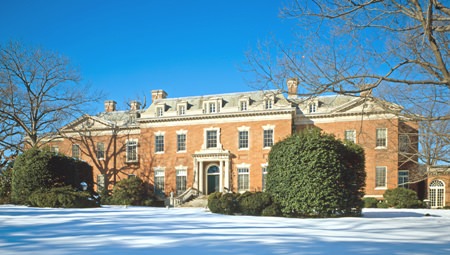One day, during my time as an impoverished music student in London, I was ferreting through the records in a second-hand music shop and came across one of those rather unusual 45rpm classical recordings. It was recorded by the London Mozart Players (founded in 1949 and still going strong) and featured Stravinsky’s Dumbarton Oaks Concerto. I bought the record without hesitation and didn’t regret it.
We have to thank the absurdly-wealthy American diplomat Robert Woods Bliss and his wife Mildred for this piece. To mark their thirtieth wedding anniversary in 1938, they commissioned a new work from Igor Stravinsky, then one of the superstar musicians of the day and much in demand as a composer and conductor. As a result of the commission, he wrote the Concerto in E-flat for Chamber Orchestra while staying in a town near Geneva where his eldest daughter was fighting a terminal battle with tuberculosis.
 It’s not much, but it’s home: Dumbarton Oaks.
It’s not much, but it’s home: Dumbarton Oaks.
The work was first performed in the grandiose music room of the Bliss house, rustically named Dumbarton Oaks. For years, I had pictured a homely, rambling country house with roses and wisteria everywhere blissfully unaware that Dumbarton Oaks was actually an enormous nineteenth century building of palatial proportions, situated in Washington’s up-market Georgetown neighborhood. Even so, the name provided a convenient and enduring nickname for the concerto. As fate would have it, on the day of the first performance Stravinsky was in hospital with tuberculosis (though he lived to tell the tale) and the ensemble was conducted by the legendary teacher and musician Nadia Boulanger.
During the 1920s, Stravinsky had become profoundly interested in a neoclassical approach to composition which he later claimed to have invented himself. This drew on some of the aesthetic principles vaguely associated with European music’s Classical Period which was roughly between 1750 and 1820. Although Stravinsky wrote some of the best-known neoclassical works in the repertoire, other composers notably Hindemith, Prokofiev, Bartók, Milhaud and Poulenc were also influenced by neoclassical principles.
If your knowledge of Stravinsky’s music is through the ballets written before the First World War, this work may come as a pleasant surprise. Stravinsky first explored the neoclassical approach in his ballet Pulcinella which dates from around 1920 and was based on melodies presumed at the time to have been written by the eighteenth century Italian composer Giovanni Pergolesi. As it turned out, they weren’t, but the ballet began Stravinsky’s long fascination with neoclassical principles. The Concerto in E-flat is a three-movement work written along the lines of a baroque concerto grosso in which unlike a conventional concerto, a group of instruments perform the solo sections. It’s scored for ten stringed instruments, a handful of woodwind and two horns.
Perhaps “neo-baroque” would be a more appropriate description, because you’ll hear fascinating echoes of Bach’s Brandenburg Concerto No 3 emerging through the light and airy textures, with snippets of melody that sound as though they’ve come from dance music of the thirties. The light and delicate second movement is followed by an energetic finale that’s full of melodies, shifting accents and driving rhythms and although the music turns the clock back to the eighteenth century for its inspiration, the sound is pure Stravinsky.
Prokofiev wrote this work during 1916-17, which puts Stravinsky’s claim to be the “inventor of neoclassicism” on somewhat shaky ground. Prokofiev was in his mid-twenties and already a successful composer with several operas, ballets and other orchestral works to his credit, including his first two piano concertos.
The Classical Symphony draws on the musical style of Joseph Haydn for its inspiration and has become Prokofiev’s most popular orchestral work. Prokofiev once commented that “if Haydn were alive today, he would compose as he did before, but at the same time would include something new in his manner of composition”.
The work is scored for small orchestra and the format is pretty similar to the symphonies with which Haydn would have been familiar except that the traditional minuet is replaced with a gavotte. Prokofiev uses techniques that Haydn would have recognised, yet the musical language is unmistakably his own, with jaunty playful rhythms and spiky melodies. There’s a lovely lyrical second movement and an elegant gavotte which contains surprisingly satisfying twists of harmony. The brilliant finale is a scampering movement which contains plenty of lively tunes. There’s an especially catchy one, first heard on the flute (at 11:23) that you might find yourself humming for a long time afterwards.
The performance by these Danish musicians is staggeringly good. Listen out for the brilliantly virtuosic woodwind playing in the last movement.





